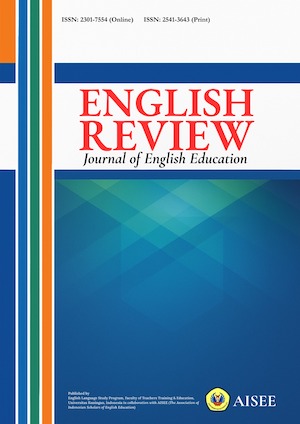THE LOCAL-GLOBAL INNOVATION OF AN INDONESIAN TOEFL-LIKE GAME: A CULTURAL HYBRIDITY MODEL
Abstract
The door to globalization for an Indonesian product is believed possible only when fulfilling some characteristics of other nation’s culture. To ensure the global popularity of a product, therefore, there is a need of mixing the local with a global culture. The cultural hybridity strategy of mixing local-global scenes is evident in the invention of a TOEFL-like game software, which based itself on a mobile application for its platform. With the platform, the game becomes easily downloadable through Google Playstore. It is innovative as it accommodates the Generation Z’s characteristics who are digital savvy. In the game, an animation is created for Listening section which takes in some forms of Javanese culture that are made hybrid with some American and Japanese ones. In finding out how successful the game is in fulfilling the needs of TOEFL-like game players, a Technology Accepted Model questionnaire is given to students from Indonesia and Japan. Japanese players, who are English Department students, were chosen on the assumption that they are more digital savvy. This article reports that the game is useful and beneficial in raising the English competence of both Indonesian and Japanese students. With the cultural hybridity strategy in creating the animation, the players agree that the game is a good model for learning about the English language in a fun and innovative way.References
Buchanan, R., & Murray, T. (2018). ’The internet is all around us’: How children come to understand the internet. Digital Culture & Education, 10(July), 1–21. Retrieved from http://www.digitalcultureandeducation.com/cms/wp-content/uploads/2018/07/Murray and Buchanan.pdf.
deHaan, J. (2011). Teaching and learning English through digital game projects. Digital Culture Education, 3(1), 46–55. Retrieved from: https://doi.org/10.1111/j.1747-7379.2003.tb00155.x.
Derakhshan, A., & Khatir, E. D. (2015). The effects of using games on english vocabulary learning. Journal of Applied Linguistics and Language Research, 2(3), 39–47. Retrieved from http://www.jallr.com/index.php/JALLR/article/view/40.
Donmus, V. (2010). The use of social networks in educational computer-game based foreign language learning. Procedia - Social and Behavioral Sciences, 9, 1497–1503. Retrieved from: https://doi.org/10.1016/j.sbspro.2010.12.355.
Dukut, E. M. (2018). Popularizing Indonesian scenes through picturebooks and digital animation software: A world Englishes teaching idea. Asian Englishes. Retrieved from: https://doi.org/10.1080/13488678.2018.1459071.
Hamdani, T. (2018). Lamar CPNS di instansi ini harus kuasai bahasa Inggris. Retrieved from: https://finance.detik.com/lowongan-kerja/d-4222370/lamar-cpns-di-instansi-ini-harus-kuasai-bahasa-inggris.
Kleinshmit, M. (2015). Generation Z characteristics: 5 infographics on the Gen Z lifestyle. Retrieved from: https://www.visioncritical.com/generation-z-infographics/.
Kompasiana. (2016). Gen Z, bonus demografi, dan masa depan Indonesia. Retrieved from: https://www.kompasiana.com/yudikurniawan/583fc7f9ba22bda00c8d8bf9/gen-z-bonus-demografi-dan-masa-depan-indonesia.
Lubis, M. (2016). Gen Z: Konsumen potensial masa depan. Retrieved from: https://www.nielsen.com/id/en/press-room/2016/GEN-Z-KONSUMEN-POTENSIAL-MASA-DEPAN.html.
Mohr, K. A. J., & Mohr, E. S. (2017). Understanding Generation Z students to promote a contemporary learning environment, 1(1). doi: 10.15142/T3M05T.
Nalliveettil, G. M., & Alenazi, T. H. K. (2016). The impact of mobile phones on English language learning: Perceptions of EFL undergraduates. Journal of Language Teaching and Research, 7(2), 264–272. Retrieved from: https://doi.org/http://dx.doi.org/10.17507/jltr.0702.04.
Nurhayati, N., & Nehe, B. M. (2016). An analysis of students’ strategies in answering TOEFL. The Journal of English Language Studies, 01(01), 10–18. Retrieved from: http://jurnal.untirta.ac.id/index.php/JELS/article/view/682/535.
Nusaresearch. (2017). Mobile games trend in Indonesia 2017 behavior of mobile games usage, (August). Retrieved from: https://doi.org/10.1038/320124a0.
Pieterse, J. N. (2006). Globalization as hybridization. In M. G. Durham & D. M. Kellner (Eds.), Media and cultural studies: Kyswore (pp. 658–680). Cornwall: TJ International Ltd.
Purcell, K., Entner, R., & Henderson, N. (2010). The rise of apps culture. Retrieved October 1, 2018, from: http://www.pewinternet.org/2010/09/14/the-rise-of-apps-culture/.
Putri, E. (2016). Generasi X, Y, Z, Alpha, Baby Boomers: Termasuk yang manakah kamu? Retrieved from: https://magazine.banananina.co.id/generasi-x-y-z-alpha-baby-boomers-termasuk-yang-manakah-kamu/.
Seemiller, C., & Grace, M. (2016). Generation Z goes to college. New York: Jossey-Bass.
Statista.com. (2018). Number of mobile phone users in Indonesia from 2013 to 2019 (in millions). Retrieved September 30, 2018, from: https://www.statista.com/statistics/274659/forecast-of-mobile-phone-users-in-indonesia/.
Sterling, G. (2017). Move over millennials, Gen-Z now the largest single population segment. Retrieved from: https://marketingland.com/move-millennials-gen-z-now-largest-single-population-segment-219788.
Surati, S. (2014). Strategi pembangunan game edukasi berbasis desktop untuk anak usia 4-6 tahun. Journal Speed-Sentra Penelitian Edukasi Dan Engineering, 6(1), 8–17.
All articles published in English Review: Journal of English Education (ERJEE) are licensed under the Creative Commons Attribution 4.0 International License (CC BY 4.0).
Copyright Ownership
Authors retain the copyright of their articles and grant ERJEE the right of first publication. The journal is granted a non-exclusive license to publish, reproduce, and distribute the article in any format, medium, or platform, provided that proper credit is given to the original authors.
License Terms – CC BY 4.0
Under the Creative Commons Attribution 4.0 International License, others are free to:
- Share — copy and redistribute the material in any medium or format
- Adapt — remix, transform, and build upon the material for any purpose, even commercially
As long as they:
- Provide appropriate credit to the original author(s) and source
- Provide a link to the license (https://creativecommons.org/licenses/by/4.0/)
- Indicate if any changes were made
There are no restrictions on the reuse, reproduction, or adaptation of published articles as long as attribution is properly given.
Author Warranties
By submitting a manuscript to ERJEE, authors confirm that:
- The work is original and does not infringe any existing copyright.
- The manuscript has not been previously published and is not under consideration elsewhere.
- All sources and references are appropriately acknowledged.
- Necessary permissions have been obtained for any copyrighted materials used.









